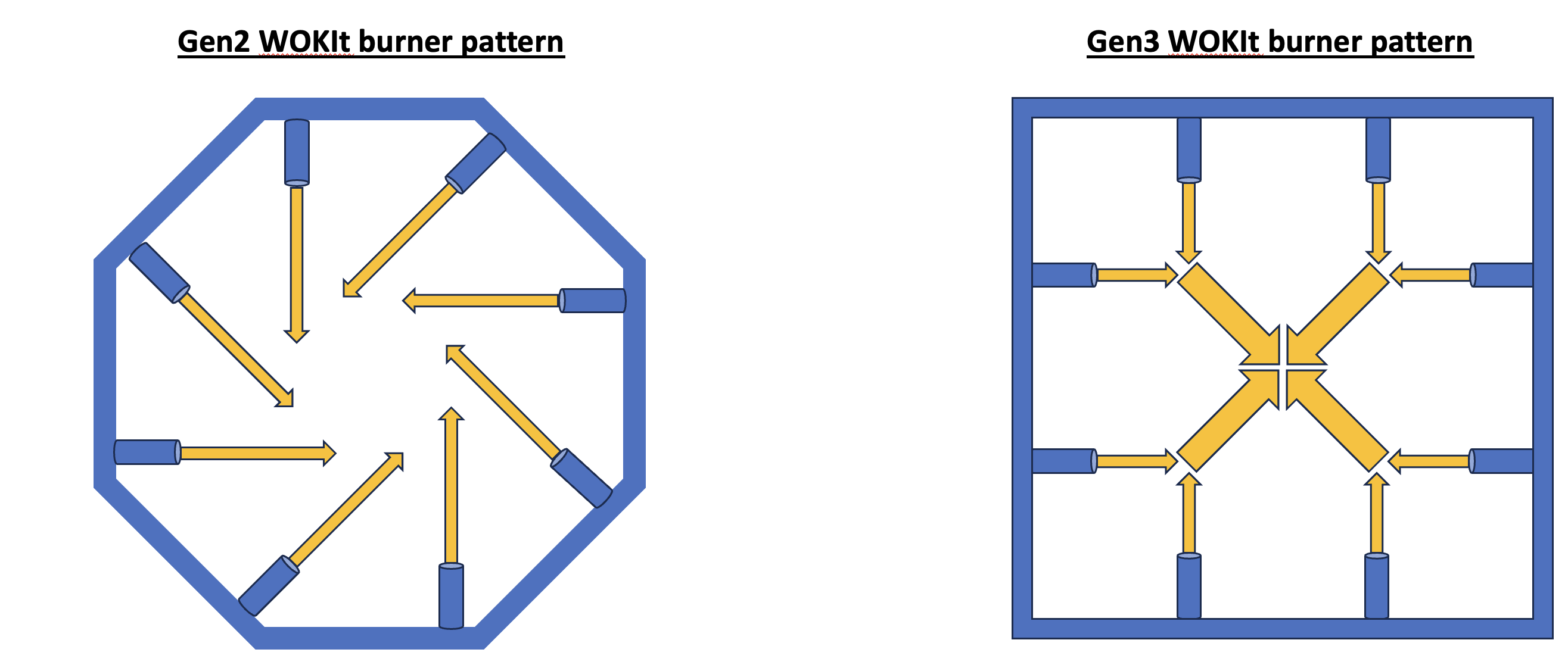Wok burners, WOKits, BTUs part II: Reviewing the WOKit Gen3 and an induction wok
Finding the best wok burner isn't just about BTUs or Watts. Updated with a review of the WOKIt third generation and an electric induction burner.

This post is an update from my original article "Wok burners, WOKits, BTUs and Wok Hei" which has proven to be a rather popular read. The article talked about the important of flame pattern and then walked through a number of different burner designs I have experienced over the years. Since I wrote that article, I've been lucky enough to get my hands on a couple of new gadgets:
- A new version of the WOKit - I'm calling it the "third generation" burner out of Germany. The version I have installed previously I think is generation 2 and I was never able to try one of the original first-generation units that had a burner milled out of solid metal.
- A high output, 220V 3600W induction wok cooker with a curved bowl, designed for round-bottom woks.
I thought I'd post a review of these wok burners to see how they stack up against the best previously - the Gen2 WOKIt.
Power vs. flame pattern: A quick reminder
The majority of users buying wok burners are obsessed by the power output of the device, typically measured in BTUs or Watts. In fact how this power is delivered to the wok is more important than the absolute quantity of power present. My previous article, as well as this article by Kenji at Serious Eats, does a good job illustrating how very powerful flames often end up escaping the sides of the wok and just heating the surrounding air instead of the food.
This is why the electric induction wok was such an interesting thing for me to try: Gas wok burners have an incredibly low efficiency. For example, to heat 2L of water from 30C to 99C in 2 minutes should only require 4,800W of power, yet in practice it takes 10,000W-20,000W to do so on common wok burners with round-bottomed woks. The induction burner is 85% efficiency combined with maybe 5%-25% for gas burners.
Serious wok cooking starts with a round-bottomed wok for ease of stirring, tossing, frying, dealing with small quantities of sauce and oil etc. The ideal flame pattern in such cooking results in the bottom of the wok being the hottest, with a nice even temperature gradient up the sides of the wok, but no flames shooting up into the air. We evaluate the pattern of both burners looking at their heat pattern.
Review: WOKIt Gen3
The Gen3 WOKit is now on sale on web site Brennermanufaktur, viewable in English with the Opera Google Translate plugin. The latest evolution has been designed to allow easier manufacturing at scale and improved efficiency. The controls are also nicer, with a solid metal knob instead of a black plastic one.
Change in jet burner design and alignment
Internally, the gas plumbing is no longer copper with compression fittings bent into an octagon but welded stainless steel in a square. I'm told this makes things much easier to manufacture and align and has the side benefit that it will also help the device get regulatory approvals in future markets like the USA that don't permit copper pipe and compression fittings to be used for gas.
With the change in burner ring comes a change in flame pattern, illustrated here:

The Gen2 WOKIt aligns 8 jet burners creating a vortex to draw air into the flames and focus them at the centre of the wok. The Gen3 sticks with 8 jets but instead aligns them such that the flames impinge in two levels. Two jets meet at 90 degrees in each corner, combining into one much larger jet shooting towards the centre. The four larger jets then smash into each other in the middle, resulting in a column of fire that shoots straight up from the middle of the burner bowl.
Improvement in wok ring assembly
The wok ring assembly in the new model is very different. Although it's slightly taller, which is a little less visually appealing, it is a substantial improvement in cooking performance. It actually insets the wok within the rings a little bit, allowing more flame (and thus heat) to come in contact with the wok, and less with the outer ring.
Those who have cooked on the older WOKIt will be used to the upper burner ring glowing red after intense cooking sessions. This doesn't happen with the new ring, and instead the heat energy is passed to the wok. This also creates a less abrupt temperature gradient.
The flame pattern is perfect. Here is a picture of my 15.5 inch cast iron wok just heating up empty:

The red hot part literally glows right at the bottom. The extremely hot ring is still so hot it's stripped off the seasoning. The Hot section is still hot enough that any residual oil has burned off. This is exactly what you see when the blower-assisted 50,000W burners in restaurants in Hong Kong heat up their woks, although they are admittedly bigger and heat even faster.
I don't have such a picture for the Gen2, but it has a much more sudden temperature drop outside the Extremely Hot ring, such that one would only see two rings rather than three unless holding the wok up a bit.
Recommendation
This is still the best domestic wok burner I've seen on the market!
On high heat cooking, the Gen3 WOKIt is actually better to cook with than the Gen2. On the Gen2, I would often hold the wok forward to let flames pass better without hitting the ring, but with the Gen3 there's no need to do so. The new model has an even better temperature gradient, is more efficient, and the fit and finish feels better.
In terms of niggles, the older burner design is slightly more even on the lowest heat setting, creating 8 small hotspots rather than four larger ones. At the end of the day this barely matters since we don't buy wok burners for cooking on the lowest possible setting: Most of the time is spent either off (pilot only, when seasoning or adding things to the wok) or full power (stir frying). The other minor niggle would be that the knob is also no longer in the middle, meaning I have to criss-cross my hands to change the setting since I'm right handed; perhaps I could have ordered it the other way round.
Overall, though, based on my experience the Gen3 is definitely a Buy, and overall a worthwhile improvement over the Gen2. I wouldn't however upgrade my Gen2 unit in London with a Gen3 since the former still works so incredibly well.
Review: Induction wok burner
The induction burner in question was purchased from a specialised induction restaurant supply store in Yau Ma Tei, HK. They sell induction appliances of all types and sizes, from massive standalone cooking stations to tiny tabletop ones. This unit is somewhere in between the two, being of a size and capacity that should constitute a lower-end professional unit.
Considering the inefficiencies of gas cooking, the 3600W induction burner should have the equivalent heat output to the wok of around 11,000W of gas burner, or 37,500BTU. This is a serious amount of cooking power, broadly comparable to the WOKit's 14,000W. The burner bowl appears to be made of some sort of plastic or glass-type material with circular electric coil wound just under the surface. The unit has a fairly loud fan which remains on for a minute or two after cooking. Controls are intuitive, with a knob used to increase or decrease the power output (measured in watts).
I turned it onto full power and the cast iron wok smoked almost immediately - a good sign, definitely not your normal electric cooker. I then added in oil and vegetables and started cooking. I found the wok largely impossible to toss because, while the wok can be smoothly rotated in the bowl, it can't be lifted, pulled backwards or pushed forward making it hard to actually stir fry properly. So I worked with the spatula, moving things around as fast as I could.
Unfortunately, despite me moving quite quickly and my spatula hand not stopping, my vegetables came out burned, with a small pool of water sitting at the very bottom of the wok. Feeling disappointed, I investigated why this was the case (the 'flame' pattern at fault, again) and tried again a few times until I learned to cook with this thing.
The heat pattern is the problem
Here is a photo of water boiling in the wok, which is one way to see where the metal in the wok is the hottest. As the water approaches boiling point, small bubbles will form on the hottest parts of the wok. Like the picture for the WOKIt, I've annotated it to show what's going on:

What we see here is a donut - a cold spot in the bottom, a hot ring, a lukewarm area then cold up the edges. The cold spot right at the bottom of the wok allows liquid to pool at the bottom, much like many gas burners. On the sides, there isn't a temperature gradient: Where the burner bowl ends, the wok goes from extremely hot to very cold almost immediately. As food is moved around, it either stays cold (at the very bottom or sides) or incinerates (in the donut).
This explains what's going on: This equivalent 11,000W of cooking power is concentrated in a very small part of the overall wok surface. Meaning it's so hot the food burns almost instantly. Elsewhere, it doesn't cook and water pools around. Leading to burned, somewhat soggy vegetables.
Learning to cook with this thing
As I've used the device more and more, I've got better at cooking with it. I'm in the habit of rotating the wok a fair bit when cooking with it to try and even out the temperature distribution. It is a pain though, and still doesn't yield results anywhere near as good as a proper gas burner. If the rotation stops the food is prone to burning, so I also use it with the power output set to 2400W.
One obvious thing would be to find a curved wok containing some copper or aluminium to improve conduction. Such a wok would probably be stainless steel clad so it still works with induction, but also wouldn't take seasoning or char well. I've not looked for such a wok since it also sounds quite expensive.
Recommendation
I'd only recommend this if gas is completely unavailable, the purchaser is really serious about wok cooking, and willing to learn new techniques. Personally I'd far sooner take a much lower powered domestic gas hob with a good burner pattern and standard power output over this device. That sais, I'd take this device over a flat wok on an induction cooktop, simply because one can still use a good sized round-bottomed wok and it doesn't have the sort of temperature-based shutoffs that a lot of domestic induction units often do.
